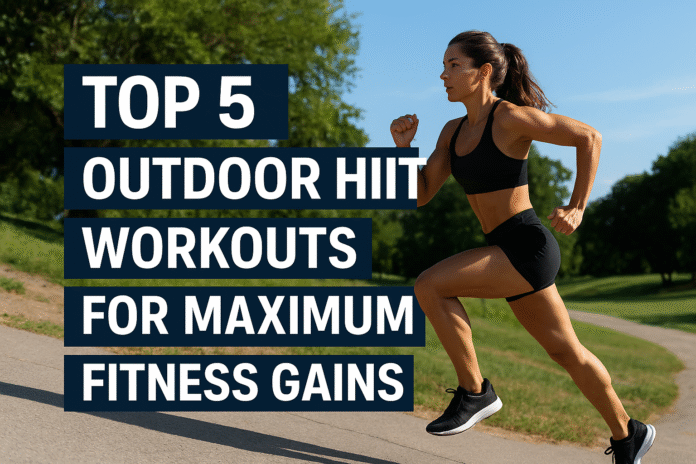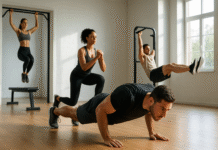High-intensity interval training (HIIT) outdoors is one of the fastest, most efficient ways to boost aerobic fitness, build lean muscle, and burn calories—all without a gym membership. In this article you’ll find five ready-to-run outdoor HIIT workouts (each with step-by-step instructions), practical warm-ups, progressions, safety rules, a 4-week starter plan, troubleshooting tips, ways to measure progress, and 10 FAQs. This guide is written for busy adults, outdoor lovers, and athletes who want maximum fitness gains from short, effective sessions in parks, on trails, or on neighborhood streets.
Medical & safety note: HIIT is demanding. If you have pre-existing medical conditions, are pregnant, or haven’t exercised in a long time, consult a qualified healthcare professional before beginning any vigorous program.
Key takeaways
- Short, intense bursts of work followed by recovery produce big fitness returns in less time than steady cardio.
- Warm up 5–10 minutes and cool down after every HIIT session; this reduces injury risk and improves performance.
- Pick one to three HIIT sessions per week at first; combine with strength and recovery days for best results.
- Progress gradually—start with beginner intervals and increase intensity, duration, or rounds over weeks.
- Measure results with simple metrics: perceived exertion, interval times, heart-rate response, and increases in work completed.
- Safety first: monitor fatigue, form, environment (surface, weather), and allow adequate recovery.
Why outdoor HIIT works (quick primer)
Outdoor HIIT relies on short periods of near-maximal effort followed by rest or light activity. That structure taxes both aerobic and anaerobic systems, prompting improvements in cardiovascular capacity, speed, and metabolic health while keeping sessions short and flexible. Outdoors you also gain variety—terrain, hills, stairs, and open space make interval structure natural and engaging, while fresh air and sunlight support mood and consistency.
How to use this article
No follow-ups needed—each of the five workouts below is a self-contained plan you can try right away. If you’re new to HIIT, start with the beginner options and use the 4-week plan near the end to build safely.
Safety & basic readiness checklist (before any outdoor HIIT session)
- Comfortable clothing and supportive shoes appropriate for terrain.
- Phone, water, and ID (and sunscreen if exposed).
- Check the environment: dry surface, good visibility, no heavy traffic, and safe temperatures.
- 5–10 minute dynamic warm up ready (see warm-up checklist).
- Timer, watch, or interval app (optional but helpful).
- If you use heart rate: know your resting heart rate and approximate max heart rate method.
- If you feel chest pain, dizziness, or unusual shortness of breath, stop and seek help.
Workout 1 — Hill Sprints: Pure Power & Speed
What it is and core benefits
Hill sprints are short maximal efforts uphill. They develop speed, explosive power, and cardiovascular fitness while being lower impact on joints compared to flat sprinting (because the incline shortens stride and reduces ground-impact forces). Hills also increase muscular demand on the glutes, hamstrings, calves, and core.
Core benefits: improved sprint power, faster acceleration, higher muscular recruitment, and time-efficient anaerobic conditioning.
Requirements / prerequisites
- Equipment: None required. Optional: stopwatch or interval timer.
- Skills: Ability to run briskly uphill for 10–30 seconds with safe running form.
- Cost: Free.
- Low-cost alternatives: Use a treadmill at 6–10% incline set to sprint speed, or repeat flat 30-m “all-out” runs.
Step-by-step beginner implementation
- Find a hill with moderate grade (4–8% incline). Distance of 40–80 meters is ideal.
- Warm up 8–10 minutes: brisk walk → light jog → dynamic mobility (leg swings, lunges) → 2 progressive stride accelerations.
- Set the timer or mark the top. Aim for 8–12 seconds all-out on the first few sessions.
- Perform 4 repeats: sprint uphill 8–12 seconds, walk slowly back for recovery (1.5–3 minutes).
- Cool down 5–8 minutes: easy walk, light stretching.
Beginner modifications and progressions
- Simplify: Reduce sprint time to 6–8 seconds and increase recovery to 3–4 minutes.
- Progress: Add one repeat each week until you reach 8–10 repeats. Increase sprint time to 15–20 seconds for more challenge.
- Alternate progression: Keep sprint duration constant but shorten recovery gradually.
Recommended frequency / duration / metrics
- Frequency: 1–2 hill sprint sessions per week.
- Session duration: 20–30 minutes total including warm up and cool down.
- Metrics to track: sprint duration, number of repeats, perceived exertion, and how fast recovery heart rate drops (beats per minute decrease in the first minute).
Safety, caveats, common mistakes
- Mistake: Overreaching on first sessions—keep repeats short and safe.
- Caveat: Steep or unstable hills increase risk of fall; choose firm footing.
- Safety tip: Maintain short, quick turnover uphill; do not overstride. Walk back for full recovery to preserve sprint quality.
Mini sample plan (2–3 steps)
- Warm up 8 minutes.
- 6 × 10-second hill sprints, walk back recovery 2.5 minutes.
- Cool down 5 minutes.
Workout 2 — Tabata Bodyweight Circuit: Fast Fat-Blasting
What it is and core benefits
Tabata is a HIIT format characterized by 20 seconds of max effort followed by 10 seconds rest, repeated for 8 rounds (4 minutes total per exercise block). Outdoors you can assemble a circuit of bodyweight moves (e.g., burpees, push-ups, jump squats, mountain climbers).
Core benefits: maximizes calorie burn in a compact time, improves anaerobic capacity, and builds muscular endurance.
Requirements / prerequisites
- Equipment: None; a small towel or mat optional.
- Skills: Basic bodyweight movement competency and the ability to maintain a high but controlled intensity for 20 seconds.
- Cost: Free.
- Low-cost alternatives: Use a parking lot, sidewalk, or playground grass.
Step-by-step beginner implementation
- Warm up 6–8 minutes: light jog, hip and shoulder mobility, 30 seconds of easy jumping jacks.
- Pick 3–4 exercises—example set: burpees, squat jumps, incline push-ups (on a bench), mountain climbers.
- Tabata block: 20 s work / 10 s rest × 8 for Exercise A (4 minutes). Rest 60–120 s between blocks.
- Total: 2–3 Tabata blocks (8–12 minutes high-intensity work) depending on fitness.
- Cool down 5–8 minutes: walk and static stretch.
Beginner modifications and progressions
- Simplify: Use push-ups on a bench or knee push-ups; replace jump squats with bodyweight squats.
- Progress: Replace incline push-ups with full push-ups; add a 4th Tabata block; reduce rest between blocks.
- Volume progression: Start with 2 blocks and add a block every week as adaptation permits.
Recommended frequency / duration / metrics
- Frequency: 1–3 Tabata sessions weekly (start with one if new).
- Duration: Each session 20–30 minutes total including warm up and cool down.
- Metrics: number of reps per 20-second work period (track improvement), RPE (rate of perceived exertion), and recovery breathing rate.
Safety, caveats, common mistakes
- Mistake: Sacrificing form for reps—reduce speed if form breaks down.
- Caveat: High-impact moves are taxing on knees/ankles; substitute lower-impact moves if needed.
- Safety tip: Choose stable ground; be cautious of wet or uneven surfaces.
Mini sample plan (2–3 steps)
- Warm up 8 minutes.
- Tabata block A (burpees) + 90 s rest + Tabata block B (squat jumps) = 2 blocks.
- Cool down 5 minutes.
Workout 3 — Plyometric Park Routine: Explosive Strength & Agility
What it is and core benefits
Plyometrics involve explosive, fast contractions (jumps, bounds). Done outdoors using benches, curbs, or flat ground, plyo HIIT develops power, speed, reactive strength, and coordination—beneficial for athletes and runners.
Core benefits: greater explosive strength, improved running economy, and enhanced neuromuscular power.
Requirements / prerequisites
- Equipment: Park bench or curb (optional), flat open space.
- Skills: Basic single-leg and two-leg landing competency; no current joint pain.
- Cost: Free.
- Low-cost alternatives: Sand (if near beach) for softer landings; grassy areas reduce impact.
Step-by-step beginner implementation
- Warm up thoroughly 10 minutes: dynamic mobility (ankle circles, leg swings), light skips, and 2 × 20-m stride accelerations.
- Choose 4 moves: tuck jumps, bounding (alternating single-leg hops), bench step-ups with explosive drive, lateral skater hops.
- Work interval: 20–30 seconds of controlled explosive reps, then 60–90 seconds active recovery (walk).
- Perform 3–5 rounds of the 4-exercise circuit (12–20 minutes high tempo).
- Cool down 6–8 minutes and emphasis on calves, quads, hamstrings stretching.
Beginner modifications and progressions
- Simplify: Replace tuck jumps with high knee marches; do step-ups instead of box jumps.
- Progress: Increase work time to 30 seconds, reduce recovery to 45–60 seconds, add more rounds.
- Skill work progression: Introduce single-leg bounds once bilateral landing is stable.
Recommended frequency / duration / metrics
- Frequency: 1 plyo HIIT session every 7–10 days if also strength training; 1–2 weeks if not.
- Duration: 20–30 minutes total.
- Metrics: jump height (subjective or measured), reps per interval, and perceived stiffness or soreness (track to avoid overuse).
Safety, caveats, common mistakes
- Mistake: Excessive volume too often—plyos need recovery to avoid Achilles/calf issues.
- Caveat: Poor landing technique increases injury risk—land softly with knees aligned over toes.
- Safety tip: Keep sessions short, focus on quality of each jump, and stop if pain or unusual tightness occurs.
Mini sample plan (2–3 steps)
- Warm up 10 minutes.
- Circuit: 20 s tuck jumps → 60 s walk → 20 s lateral skaters → 60 s walk → 20 s bench step-ups → repeat x4.
- Cool down 6 minutes.
Workout 4 — Stair/Bleacher Intervals: Strength + Cardio Combo
What it is and core benefits
Stair workouts use stadium steps or public bleachers to combine cardiovascular intervals with lower-body strength. Climbing stairs increases work per step, challenges the posterior chain, and offers versatile interval design (fast climbs, double-step hops, bounding).
Core benefits: builds leg strength and power, raises aerobic capacity, and is low-equipment.
Requirements / prerequisites
- Equipment: Access to safe stadium stairs or long public staircase.
- Skills: Basic stair climbing competency; balance.
- Cost: Free.
- Low-cost alternatives: Use a steep flight of neighborhood steps or portable step on flat ground.
Step-by-step beginner implementation
- Warm up 8–10 minutes: walk, step-ups on first few stairs, ankle mobility.
- Classic interval: sprint up 20–30 steps at controlled maximal effort (drive with arms), walk down slowly as recovery.
- Starter set: 6 repeats with 2–3 minutes total recovery (walking down counts).
- Cool down 6–8 minutes with slow walking and calf stretching.
Beginner modifications and progressions
- Simplify: Walk briskly up and down for 30–60 seconds instead of sprinting.
- Progress: Add loaded carries (light backpack), increase repeats, or perform double-step bounding for power.
- Alternate: Do sets of stair tempo (steady climb for 2–4 minutes) for aerobic building.
Recommended frequency / duration / metrics
- Frequency: 1 stair HIIT session per week (start here if new).
- Duration: 20–35 minutes including warm up/cool down.
- Metrics: number of stairs climbed per session, average ascent time, perceived effort, and recovery heart-rate decline.
Safety, caveats, common mistakes
- Mistake: Rushing descent—control your walk down to reduce fall risk.
- Caveat: Knees can be sensitive—avoid excessive deep knee bending on descent if you have joint pain.
- Safety tip: Choose well-lit stairs, avoid wet steps, and keep hands free for balance.
Mini sample plan (2–3 steps)
- Warm up 8 minutes.
- 6 × sprint up 20 steps (walk back down fully controlled).
- Cool down 6 minutes.
Workout 5 — Outdoor Cycling Intervals: Low-Impact HIIT
What it is and core benefits
Bike intervals performed outdoors (on a road or protected path) provide high cardiovascular stress with lower impact on joints. Cycling HIIT suits longer efforts (30 seconds to several minutes of work), and is ideal for people who prefer low-impact conditioning or who are returning from running-related injuries.
Core benefits: improved aerobic and anaerobic capacity, lower joint stress, and high caloric burn when done at intensity.
Requirements / prerequisites
- Equipment: Bicycle in good repair, helmet, basic repair kit, water.
- Skills: Basic bike handling and traffic awareness.
- Cost: Varies (bike ownership) but public bike shares or rental options exist.
- Low-cost alternatives: Stationary bike interval sessions mimic outdoor intervals if weather or safety is an issue.
Step-by-step beginner implementation
- Pre-ride check: brakes, tires, chain, and helmet fit.
- Warm up 8–10 minutes riding easy with cadence increases.
- Interval format: 30 seconds all-out sprint followed by 90 seconds easy spin; repeat 8–10 times.
- Cool down 8–10 minutes easy pedaling and stretching.
Beginner modifications and progressions
- Simplify: Start with 20 s work / 100 s recovery, or steady tempo intervals (2 min hard / 3 min easy).
- Progress: Increase work to 45–60 s, shorten recovery, or add hill repeats on the bike.
- Power option: If you have a power meter, aim for 120–150% of FTP for short sprints; otherwise use perceived exertion or heart rate.
Recommended frequency / duration / metrics
- Frequency: 1–2 high-intensity cycling sessions per week.
- Duration: 30–60 minutes including warm up and cool down.
- Metrics: Interval power, cadence, heart rate peaks, or distance covered per interval.
Safety, caveats, common mistakes
- Mistake: Sprinting without scanning surroundings—watch traffic and road surface.
- Caveat: Wind and hills affect perceived effort—adjust expectations accordingly.
- Safety tip: Use routes with low traffic and let a training partner know your plan when riding alone.
Mini sample plan (2–3 steps)
- Warm up 10 minutes.
- 8 × (30 s sprint / 90 s easy) on flat bike path.
- Cool down 10 minutes.
Essential warm-up (quick-start checklist)
Do this before any HIIT session. Total time 6–12 minutes depending on workout intensity.
- General movement (2–4 minutes): brisk walk, easy jog, or light cycling to raise heart rate.
- Joint mobility (1–2 minutes): arm circles, hip circles, ankle rolls.
- Dynamic movement (2–4 minutes): leg swings, walking lunges, high knees or butt kicks.
- Activation & movement prep (1–3 minutes): 2–3 short accelerations/strides or submaximal practice reps of planned movement (e.g., 3 × 20-m accelerations before sprints).
Why this order works: general increase in circulation → joint lubrication → muscle activation prepares you neurologically and mechanically for high-intensity work.
How to measure progress (simple, practical metrics)
You don’t need lab tests. Track these consistently:
- Performance metrics: time to complete a fixed course, number of reps per interval, or sprint times.
- Physiological metrics: recovery heart rate (beats dropped in first minute after exertion), resting heart rate over weeks, or perceived exertion at a fixed workload.
- Body composition/lifting metrics: if strength is a goal, track squat or deadlift progress separately.
- Subjective metrics: energy, sleep quality, and workout recovery rating.
A sample simple progress test: time a 20-second sprint effort on week 1, then retest every 2 weeks. If time or power increases at similar perceived effort, you’re improving.
Troubleshooting & common pitfalls
Problem: Sessions feel harder each week.
Fix: Check recovery, nutrition, sleep, and ensure adequate easy days. Reduce session intensity for a week (deload).
Problem: Persistent joint pain after workouts.
Fix: Swap high-impact moves for low-impact alternatives (bike, row, or pool), check footwear, and add mobility/strength work.
Problem: Can’t finish planned repeats with quality.
Fix: Lengthen recovery intervals or reduce the number of repeats to preserve power output.
Problem: Weather (heat) limiting effort.
Fix: Shift sessions to cooler times (early morning/evening), shorten work intervals, and hydrate more often.
4-Week Starter Roadmap (beginner → intermediate)
This plan assumes 2 high-intensity sessions per week, one strength/functional day, and active recovery. Adjust if you already lift or run more.
Week 1 — Build habit
- Day 1: Tabata Bodyweight (2 Tabata blocks).
- Day 2: Strength or mobility (bodyweight squats, deadbugs, single-leg RDL 3×8).
- Day 3: Hill sprints (4 × 8–10 s sprints).
- Rest/active recovery: walks or light cycle on other days.
Week 2 — Increase volume slightly
- Day 1: Hill sprints (5 × 10–12 s).
- Day 2: Strength + mobility.
- Day 3: Plyometric park (3 rounds of 4 moves; short work).
- Include one restorative yoga/mobility session.
Week 3 — Intensify quality
- Day 1: Stair intervals (6 × moderate sprints).
- Day 2: Strength with heavier focus (add a loaded carry).
- Day 3: Tabata (3 blocks) or cycling intervals (8 × 30/90 s).
- Keep easy days easy.
Week 4 — Test & consolidate
- Day 1: Test: measure sprint time on hill or timed Tabata reps for consistency.
- Day 2: Active recovery and mobility.
- Day 3: Plyo or stair HIIT focusing on form and power.
- Evaluate progress and adjust week 5 goals (add another HIIT day if recovery is excellent).
Programming tips: balancing HIIT with other training
- Start with 1 HIIT session/week if you do heavy lifting; you’ll preserve strength gains while adding conditioning.
- If the goal is primarily cardio, 2–3 HIIT sessions a week plus 1–2 easy aerobic days works well.
- Avoid HIIT on consecutive days—your nervous system and muscles need time to recover.
- Add strength training to reduce injury risk and enhance muscular adaptations. Twice per week is practical.
Recovery strategies after HIIT
- Active recovery (easy walking or cycling) the day after helps blood flow and reduces soreness.
- Sleep and nutrition: prioritize protein intake for muscle repair and aim for 7–9 hours sleep.
- Contrast recovery: light mobility, foam rolling, and gentle stretching within 24–48 hours.
- Deload weeks every 3–6 weeks—reduce intensity/volume for a week to avoid overtraining.
Sample weekly templates (quick picks)
Busy week (3 × 30–40 minutes):
- Mon: Tabata 2 blocks + brief mobility.
- Wed: Hill sprints 6 × 10 s.
- Sat: Bike intervals 30/90 × 8.
Balanced week (5 days, including strength):
- Mon: Strength session.
- Tue: Easy ride or walk.
- Wed: Plyometric park HIIT.
- Fri: Strength session.
- Sun: Stair intervals.
10 Frequently Asked Questions
- How long should a HIIT session be?
Most outdoor HIIT sessions last 15–40 minutes including warm up and cool down. High-quality work in the 10–20 minute high-intensity range is typical. - How often can I do HIIT and still recover?
Start with 1–3 sessions per week depending on intensity, fitness level, and other training. Avoid doing HIIT on back-to-back days. - Will HIIT help me lose fat?
HIIT can contribute to fat loss when combined with proper nutrition and overall activity. It’s time-efficient but not a magic solution—total calorie balance matters. - Is HIIT safe for beginners?
Yes, if you scale intensity and volume appropriately and complete a proper warm up. If you have health concerns, consult a healthcare professional first. - Which is better: intervals or steady-state cardio?
Both have value. Intervals are time-efficient and potent for improving fitness and power; steady-state builds endurance and can be easier to recover from. Use both. - How do I know if I’m working hard enough?
Your breathing should be heavy, you should be unable to hold a full conversation during work intervals, and perceived exertion should be high during efforts. Heart-rate measures can also help guide intensity. - Can I do HIIT outdoors in extreme heat?
It’s better to move sessions to cooler parts of the day, shorten work bouts, and increase hydration. Heat raises cardiovascular strain—reduce intensity if needed. - How do I progress without plateauing?
Increase rounds, decrease recovery, lengthen work intervals, or add more challenging exercises. Rotate workout types (sprints, plyo, stairs, bike) to vary stimulus. - What if I have joint issues?
Opt for lower-impact interval forms like cycling, brisk uphill walking, or water-based intervals. Focus on strengthening supportive muscles and mobility work. - Can I combine strength training and HIIT on the same day?
Yes—preferably perform heavy strength work first, then shorter HIIT, or separate by several hours. If both are intense, consider performing on different days to maximize recovery.
Final checklist before you step outside
- Warm up done.
- Water and sun protection packed.
- Route and surface checked.
- Timer/phone and a plan (number of repeats, interval length) ready.
- Recovery window scheduled (easy day or mobility after).
Conclusion
Outdoor HIIT is flexible, powerful, and accessible. Use hills, stairs, open fields, or a bike path to build speed, strength, and cardio capacity in sessions that fit your schedule. Start slow, emphasize quality over quantity, and track simple metrics to measure progress. With consistent effort, sensible progression, and attention to recovery, you’ll see meaningful fitness gains in weeks—not months.
Call to action: Pick one of the five workouts above and try it this week—note how many reps or how fast you feel, and come back to track progress in two weeks.
References
- Narrative Review of High-Intensity Interval Training: Positive Impacts Across Populations, PMC (PubMed Central), Published 2025. https://pmc.ncbi.nlm.nih.gov/articles/PMC12027975/
- A systematic review and meta-analysis of the effectiveness of high-intensity interval training, PMC (PubMed Central), Published 2025. https://pmc.ncbi.nlm.nih.gov/articles/PMC12044783/
- High-Intensity Interval Training: For Fitness, for Health or Both?, American College of Sports Medicine (ACSM), June 2019. https://acsm.org/high-intensity-interval-training-fitness/
- Exercise intensity: How to measure it, Mayo Clinic, Reviewed/Published online (page updated). https://www.mayoclinic.org/healthy-lifestyle/fitness/in-depth/exercise-intensity/art-20046887
- Warm Up, Cool Down, American Heart Association — Healthy Living / Fitness Basics, Last reviewed Jan 16, 2024. https://www.heart.org/en/healthy-living/fitness/fitness-basics/warm-up-cool-down
- How to warm up before exercising, NHS (National Health Service), Media last reviewed Dec 8, 2023. https://www.nhs.uk/live-well/exercise/how-to-warm-up-before-exercising/
- High-intensity interval training (HIT) for effective and time-efficient exercise, PMC (PubMed Central), Published 2016. https://pmc.ncbi.nlm.nih.gov/articles/PMC4712564/
- High-intensity interval training is not superior to continuous aerobic training in reducing body fat: A systematic review and meta-analysis, ScienceDirect, 2023. https://www.sciencedirect.com/science/article/pii/S1728869X23000461
- 15 Plyometric Exercises That’ll Build Explosive Strength, SELF, Published article (practical exercise descriptions). https://www.self.com/story/a-10-minute-fat-burning-plyometric-workout-you-can-do-at-home




































